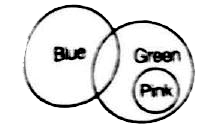Which of the following conclusion is correct.
Statement:-
I. Some blues are green.
II. All Pink are green.
(a) Some blue are pink
(b) Some green are pink
(c) Either (a) or (b) follows
(d) Some pinks are blues

Form above figure some green are definatey
Topper's Solved these Questions
- SYLLOGISMBOOK - ARIHANT PUBLICATIONCHAPTER - SYLLOGISMEXERCISE - LET US PRACTICE (BASE LEVEL EXERCISE)
18 Videos
- STATEMENT AND COURSE OF ACTION BOOK - ARIHANT PUBLICATIONCHAPTER - STATEMENT AND COURSE OF ACTION EXERCISE - LET US PRACTICE (B EXPERT LEVEL EXERCISE)
11 Videos
- VERIFICATION OF TRUTH OF THE STATEMENT BOOK - ARIHANT PUBLICATIONCHAPTER - VERIFICATION OF TRUTH OF THE STATEMENT EXERCISE - LET US PRACTICE
30 Videos
Similar Questions
In the following question below are given some statements followed by some conclusions. Taking the given statements to be true even if they seem to be at variance from commonly known facts, read all the conclusions and then decide which of the given logically follows the given statements.
Statements:
I. Some blue are yellow.
II. Some yellow are green.
Conslucions:
I. Some blue are green.
II. Some blue are not green
View SolutionIn the following question below are given some statements followed by some conclusions. Taking the given statements to be true even if they seem to be at variance from commonly known facts, read all the conclusions and then decide which of the given conclusion logically follows the given statements.
Statements:
I. Some grapes are green.
II. Some green are colour.
Conclusions:
I. Some grapes are colour.
II. Some grapes are not colour.
View Solution
Knowledge Check
Which of the following is not blue-green algae
ANostocBAnabaenaCLichenDAulosirasIn the following question below are given some statements followed by some conclusions. Taking the given statements to be true even if they seem to be at variance from commonly known facts, read all the conclusions and then decide which of the given conclusion logically follows the given statements.
Statements:
I. Some red are green.
II. All green are blue.
Conclusions:
I. Some red are blue.
II. Some blue are red.AOnly conclusion (I) follows.BOnly conclusion (II) followsCBoth conclusion follow.DNeither conclusion (I) nor conclusion (II) follows.In the following question below are given some statements followed by some conclusions. Taking the given statements to be true even if they seem to be at variance from commonly known facts, read all the conclusions and then decide which of the given conclusion logically follows the given statements.
Statements: I. Some red are green.
II. All red are yellow.
Conclusions:
I. Some green are yellow.
II. Some green are not red.AOnly conclusion (I) follows.BOnly conclusion (II) follows.CBoth conclusion follow.DNeither conclusion (I) nor conclusion (II) follows
In the following question below are given some statements followed by some conclusions. Taking the given statements to be true even if they seem to be at variance from commonly known facts, read all the conclusions and then decide which of the given conclusion logically follows the given statements.
Statements:
I. Some green are big.
II. All big are blue.
Conclusions:
I. Some blue are green.
II. Some big are green.
View SolutionIn the following question below are given some statements followed by some conclusions. Taking the given statements to be true even if they seem to be at variance from commonly known facts, read all the conclusions and then decide which of the given conclusion logically follows the given statements.
Statements:
I. Some white are red.
II. Some white are green.
Conclusions:
I. Some green are red.
II. Some red are green.
View SolutionRead the given statements and conclusions carefully. Assuming that the information given in the statements is true, even if it appears to be at variance with commonly known facts, decide which of the given conclusions logically follow(s) from the statements.
Statements:
1. Some bananas are green.
2. Some green are yellow.
Conclusion:
I. Some bananas are yellow.
II. Some yellow are bananas.
III. All yellow are bananas.
IV. Some green are bananas.
View SolutionWhich of the following is/are correct statements?
I. The wavelength of red light is greater than the wavelength of green light.
II. The wavelength of blue light is smaller than the wavelength of orange light
III. The frequency of green light is greater than the frequency of blue light
IV. The frequency of violet light is greater than the frequency of blue light
View SolutionIn the following question below are given some statements followed by some conclusions. Taking the given statements to be true even if they seem to be at variance from commonly known facts, read all the conclusions and then decide which of the given conclusion logically follows the given statements.
Statements:
I. All blue are red.
II. Some blue are pink.
Conclusions:
I. Some pink are not blue.
II. Some red are pink
View Solution
